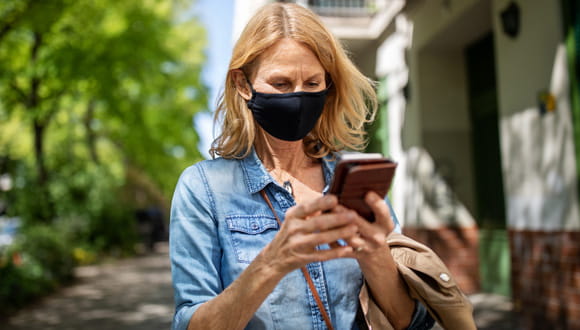6 Questions You May Have About Cloth Face Masks, Answered
June 12, 2020 - Katie McCallumThe new coronavirus that causes COVID-19 is still among us, and it's important that we all continue to do our part to help limit the spread of the virus. In addition to social distancing, that means wearing a cloth mask while in a public setting.
Your cloth face mask not only protects you, but it also helps prevent you from inadvertently spreading the virus to others if you're sick and don't yet know it. Think of your cloth face mask as part of the new social contract between you and everyone else around you during this pandemic.
But, after wearing your cloth face mask for a few months now, you probably have some logistical questions — and we've got answers.
How should my mask fit?
For your cloth mask to be effective, you'll need to be sure you're wearing it correctly.
Make sure your mask:
- Covers both your nose and mouth
- Remains secure at both the bridge of your nose and under your chin
- Fits snug to your face, but doesn't limit your ability to breathe
You'll also want to avoid touching your mask while wearing it, and, if you do, wash your hands. In addition, avoid letting it drape around your neck or rest on top of your forehead.
Lastly, don't wear a cloth face mask if you have trouble breathing, and don't put a mask on a child under the age of 2 or a person who is unable to remove a mask without assistance.
When do I need to wear my mask?
The CDC recommends wearing a cloth mask anytime you're in a public setting where maintaining social distancing is challenging.
While there's no hard and fast rule about when and where you need to wear your mask, or don't need to wear it, the likely places you can always expect social distancing to be challenging include:
- Grocery stores
- Retail stores
- Pharmacies
- Buses, trains and subways
- Gas stations
If you're going outdoors for a walk or to exercise, and expect there to be plenty of space between you and others, you can consider forgoing the mask — but it's always a good idea to have it on hand, just in case.
Does wearing a mask mean it's safe to stand closer than 6 feet to someone else?
A cloth face mask is an added layer of protection that can help reduce the spread of COVID-19 in spaces where social distancing is challenging. But, your mask is not a replacement for social distancing. Rather, it's a supplement to social distancing.
When in a public setting, it's safest to practice both social distancing and wear your cloth face mask.
What's the right way to remove my mask?
When it comes to removing your mask, you want to be sure you're doing so correctly.
Start by removing your mask using the strings or bands that secure it behind your ears. While holding only these strings or bands, fold the outside corners together and then wash or store your mask.
Try not to touch any part of your face, particularly your eyes, nose or mouth, while removing your mask, and wash your hands (or apply hand sanitizer) immediately afterwards.
How should I wash my mask and how often?
The CDC recommends washing your mask after each use, and you can wash it in a washing machine or by hand.
If using a washing machine, don't be afraid to wash your mask along with your regular laundry — with standard laundry detergent and the warmest water the cloth material of your mask can handle.
If you're washing by hand, soak your cloth mask in bleach for five minutes and then rinse thoroughly with water.
You'll want to be sure your mask dries completely after being washed, since damp cloth is a welcoming environment for mold to grow. It's probably easiest to dry your mask in your dryer, but you can also hang your mask flat to dry (ideally in a space that receives direct sunlight).
How or where should I store my mask?
Even once you know what do while wearing your mask, you may be wondering what to do with your mask when you're not wearing it.
Between usages, it's important to store your mask in a cool, dry place.
For instance, consider hanging your mask via its tie strings or bands from a hook by your door. This will also help you remember to grab your mask as you head out your door.
If you need to store your mask between uses during the day, such as while at work, consider carrying a disposable paper lunch bag to put your mask in while it's not being worn.
The keys to storing your mask between usage are to make sure that you're:
- Choosing a dry place where mildew and mold can't grow
- Folding your mask to ensure that the inner cloth that contacts your mouth remains protected from any potentially contaminated surfaces
Concerned you may have COVID-19?
- If you're experiencing COVID-19 symptoms, you can speak to a Virtual Urgent Care provider 24/7. The provider will help you determine if testing is needed and advise you on where you should go.


